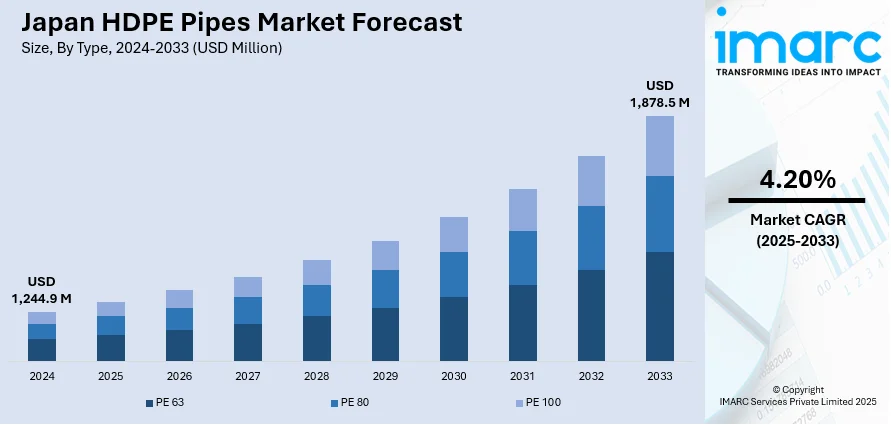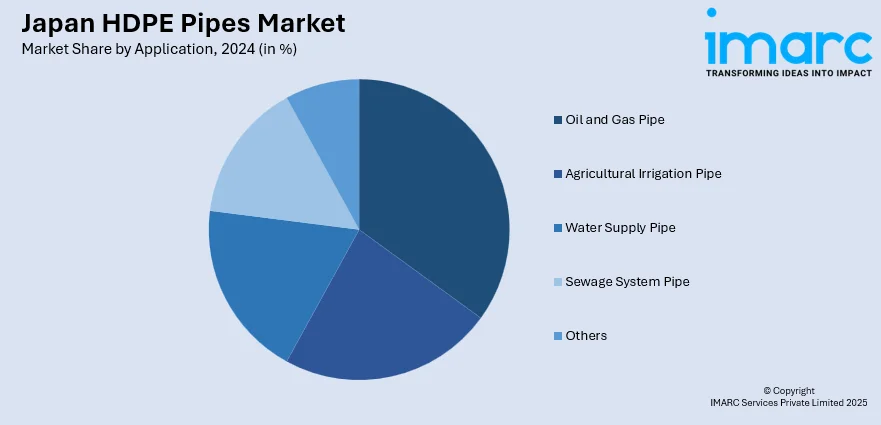
Japan HDPE Pipes Market Size, Share, Trends and Forecast by Type, Application, and Region, 2025-2033
Japan HDPE Pipes Market Overview:
The Japan HDPE pipes market size reached USD 1,244.9 Million in 2024. Looking forward, IMARC Group expects the market to reach USD 1,878.5 Million by 2033, exhibiting a growth rate (CAGR) of 4.20% during 2025-2033. Government initiatives aimed at upgrading infrastructure, enhancing disaster resilience, and replacing aging pipelines with durable HDPE pipes are supporting the market growth, particularly in critical systems such as water, sewage, and gas distribution. Additionally, the vulnerability of Japan to natural disasters is catalyzing the demand for HDPE pipes owing to their flexibility and long-term reliability.
|
Report Attribute
|
Key Statistics
|
|---|---|
|
Base Year
|
2024 |
|
Forecast Years
|
2025-2033
|
|
Historical Years
|
2019-2024
|
| Market Size in 2024 | USD 1,244.9 Million |
| Market Forecast in 2033 | USD 1,878.5 Million |
| Market Growth Rate 2025-2033 | 4.20% |
Japan HDPE Pipes Market Trends:
Government Initiatives in Improving Infrastructure
The growing efforts of the governing body on expanding and upgrading the infrastructure are driving the need for high-density polyethylene (HDPE) pipes. With the growing elderly demographic and the need for improved disaster preparedness, the governing authority is persistently dedicating resources for upgrading vital infrastructure. This involves countrywide initiatives to substitute old pipelines with contemporary materials such as HDPE, renowned for their exceptional durability and performance. Initiatives that aim to enhance water systems, sewage, and gas distribution networks utilize HDPE pipes because of their resilience and adaptability. The rising focus on disaster-resilient infrastructure, especially in areas prone to earthquakes, is further encouraging the employment of HDPE pipes, as they can endure seismic events without fracturing. As reported by the International Trade Administration (ITA), in 2023, over 730,000 bridges, 11,000 tunnels, 10,000 water gates, 470,000 meters of sewage pipes, and 5,000 harbor quays are at least 50 years old. This aging infrastructure is getting more government focus. These continuous efforts, backed by significant funding, are fueling the need for HDPE pipes, guaranteeing their persistent contribution to Japan’s infrastructure renovation. As the nation aims to swap out old systems for more durable and efficient materials, the demand for HDPE pipes is growing steadily, meeting both present and future infrastructure requirements.

Increased Focus on Disaster Recovery and Resilience
Japan's susceptibility to natural disasters, especially earthquakes, floods, and typhoons, is leading to a significant emphasis on disaster recovery and resilience in infrastructure planning. HDPE pipes are greatly appreciated for their adaptability and capacity to endure seismic events, rendering them perfect for use in areas susceptible to natural calamities. Their ability to withstand cracking under pressure and to absorb movement guarantees that HDPE pipes remain functional even following major environmental disruptions. The quick installation and simple repair of HDPE pipes also make them a favored option for urgent infrastructure repair projects. With Japan's ongoing focus on disaster readiness and robust infrastructure, the need for HDPE pipes is increasing, particularly in essential systems such as water supply, drainage, and utilities that must function during and after a disaster. For example, on August 8, 2024, an M7.1 quake hit northeast of Nichinan, Japan, emphasizing the country’s regular seismic occurrences. As reported by the United States Geological Survey (USGS), Japan has undergone eight earthquakes with a magnitude of 7 or higher in the past century, occurring within 250 kilometers of the latest event. As a reaction to these persistent natural disasters, the use of HDPE pipes for durable and adaptable infrastructure systems is growing. Their capacity to withstand stress from earthquakes and facilitate repairs during disaster recovery makes them increasingly vital in Japan's infrastructure plans.
Japan HDPE Pipes Market Segmentation:
IMARC Group provides an analysis of the key trends in each segment of the market, along with forecasts at the regional level for 2025-2033. Our report has categorized the market based on type, and application.
Type Insights:
- PE 63
- PE 80
- PE 100
The report has provided a detailed breakup and analysis of the market based on the type. This includes PE 63, PE 80, and PE 100.
Application Insights:

- Oil and Gas Pipe
- Agricultural Irrigation Pipe
- Water Supply Pipe
- Sewage System Pipe
- Others
A detailed breakup and analysis of the market based on the application have also been provided in the report. This includes oil and gas pipe, agricultural irrigation pipe, water supply pipe, sewage system pipe, and others.
Regional Insights:
- Kanto Region
- Kansai/Kinki Region
- Central/ Chubu Region
- Kyushu-Okinawa Region
- Tohoku Region
- Chugoku Region
- Hokkaido Region
- Shikoku Region
The report has also provided a comprehensive analysis of all the major regional markets, which include Kanto Region, Kansai/Kinki Region, Central/ Chubu Region, Kyushu-Okinawa Region, Tohoku Region, Chugoku Region, Hokkaido Region, and Shikoku Region.
Competitive Landscape:
The market research report has also provided a comprehensive analysis of the competitive landscape. Competitive analysis such as market structure, key player positioning, top winning strategies, competitive dashboard, and company evaluation quadrant has been covered in the report. Also, detailed profiles of all major companies have been provided.
Japan HDPE Pipes Market Report Coverage:
| Report Features | Details |
|---|---|
| Base Year of the Analysis | 2024 |
| Historical Period | 2019-2024 |
| Forecast Period | 2025-2033 |
| Units | Million USD |
| Scope of the Report |
Exploration of Historical Trends and Market Outlook, Industry Catalysts and Challenges, Segment-Wise Historical and Future Market Assessment:
|
| Types Covered | PE 63, PE 80, PE 100 |
| Applications Covered | Oil and Gas Pipe, Agricultural Irrigation Pipe, Water Supply Pipe, Sewage System Pipe, Others |
| Regions Covered | Kanto Region, Kansai/Kinki Region, Central/ Chubu Region, Kyushu-Okinawa Region, Tohoku Region, Chugoku Region, Hokkaido Region, Shikoku Region |
| Customization Scope | 10% Free Customization |
| Post-Sale Analyst Support | 10-12 Weeks |
| Delivery Format | PDF and Excel through Email (We can also provide the editable version of the report in PPT/Word format on special request) |
Key Questions Answered in This Report:
- How has the Japan HDPE pipes market performed so far and how will it perform in the coming years?
- What is the breakup of the Japan HDPE pipes market on the basis of type?
- What is the breakup of the Japan HDPE pipes market on the basis of application?
- What is the breakup of the Japan HDPE pipes market on the basis of region?
- What are the various stages in the value chain of the Japan HDPE pipes market?
- What are the key driving factors and challenges in the Japan HDPE pipes market?
- What is the structure of the Japan HDPE pipes market and who are the key players?
- What is the degree of competition in the Japan HDPE pipes market?
Key Benefits for Stakeholders:
- IMARC’s industry report offers a comprehensive quantitative analysis of various market segments, historical and current market trends, market forecasts, and dynamics of the Japan HDPE pipes market from 2019-2033.
- The research report provides the latest information on the market drivers, challenges, and opportunities in the Japan HDPE pipes market.
- Porter's five forces analysis assist stakeholders in assessing the impact of new entrants, competitive rivalry, supplier power, buyer power, and the threat of substitution. It helps stakeholders to analyze the level of competition within the Japan HDPE pipes industry and its attractiveness.
- Competitive landscape allows stakeholders to understand their competitive environment and provides an insight into the current positions of key players in the market.
Need more help?
- Speak to our experienced analysts for insights on the current market scenarios.
- Include additional segments and countries to customize the report as per your requirement.
- Gain an unparalleled competitive advantage in your domain by understanding how to utilize the report and positively impacting your operations and revenue.
- For further assistance, please connect with our analysts.
 Request Customization
Request Customization
 Speak to an Analyst
Speak to an Analyst
 Request Brochure
Request Brochure
 Inquire Before Buying
Inquire Before Buying




.webp)




.webp)












